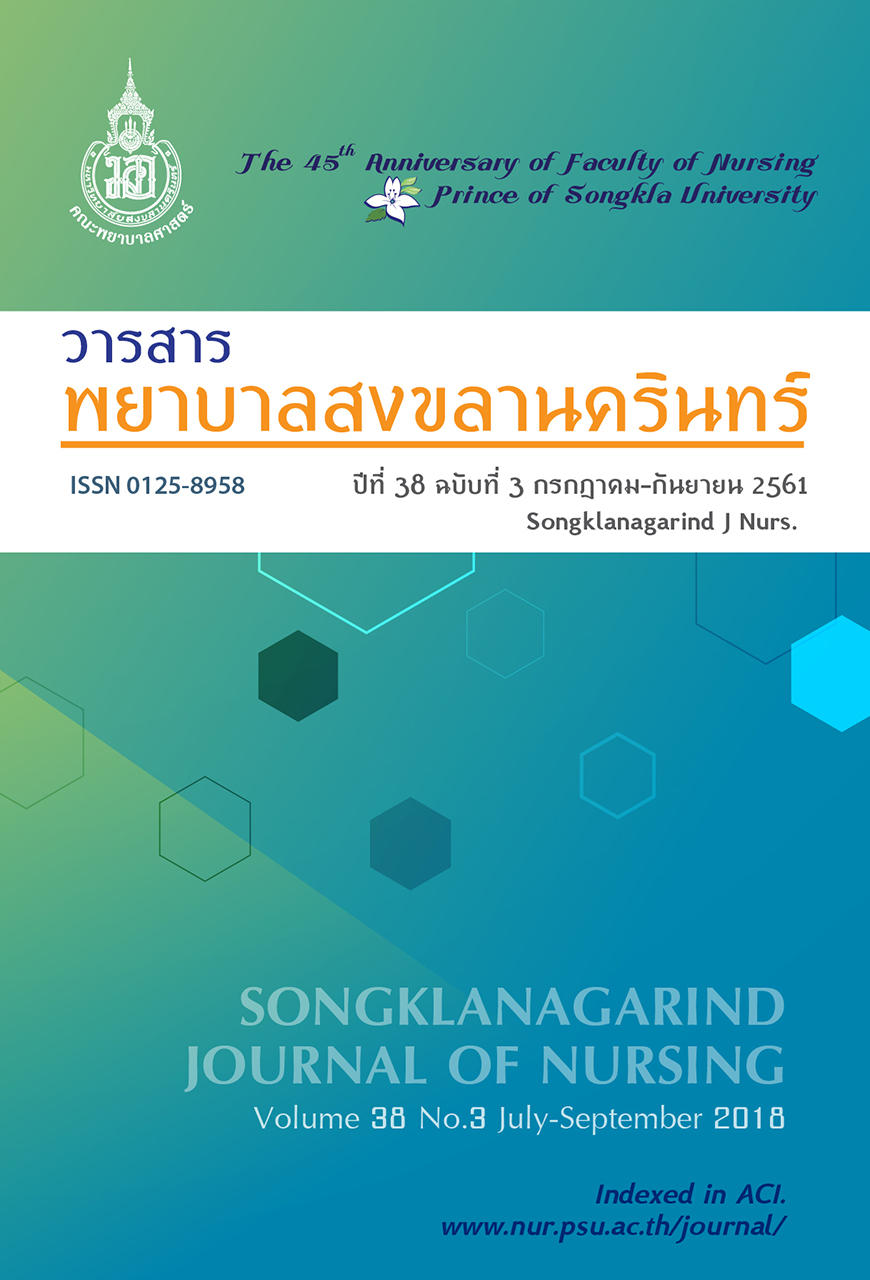Elderly Patients’ Experience in Using Emergency Medical Service at a Tertiary Hospital, Upper Northern Thailand
Main Article Content
Abstract
This qualitative research aimed to describe elderly patients’ experience in emergency medical service at tertiary care hospital, upper northern Thailand. Informants were ten elderly patients. Data were collected using individual in-depth interviews and non-participant observation. The data were analyzed using content analysis.
The findings of this study were reflected within 8 main issues included 1) detection-living alone and hesitate; 2) reporting-toll free emergency number within 24 hours in Thailand, near or far distance we are ready to serve you with a gentle attitude, could not remember the EMS call number, phobia of answer questions, and do not be afraid should be brave; 3) response-we can be give as soon as possible however traffic jam, lost, wrong way telling, and use GPS navigation; 4) on scene care-EMS team readiness goes beyond active shorter responds, trustworthiness, and patient participation in decision making; 5) care in transit-safe and security with a holistic care, and wear a seat belt in an ambulance while transported; 6) transfer to definitive care-good quality and focus on patient centered; 7) emergency department service-modernization, promptitude, separate zone for elderly patients and effective communication about waiting time; and 8) post-discharge care-car for home delivery, prepare temporary parking for relative of elderly patients, and post-discharge follow-up care. The results of this study can be used as a guideline to improve the model of emergency medical service for elderly.
Article Details
References
2. National Institute for Emergency Medicine. The national emergency medical service plan, the 3 rd version (2017-2020). Bangkok: Union Creation; 2016. Thai.
3. Shankar KN, Bhatia BK, Schuur JD. Toward patient-centered care: A systemic review of older adults’ views of quality emergency care. Ann Emerg Med. 2014; 63(5), 529-50. doi: https://doi.org/10.1016/j.annemergmed.2013.07.509
4. Platts-Mills TF, Leacock B, Cabanas JG, et al. Emergency medical services use by the elderly: Analysis of a statewide database. Prehosp Emerg Care. 2010; 14(3), 329-33. doi: 10.3109/10903127.2010.481759.
5. Huang CC, Chen WL, Hsu CC, et al. Elderly and nonelderly use of a dedicated ambulance corps’ emergency medical services in Taiwan [Internet]. BioMed Res Int; 2016 [cited 2017 June 17]. Available from: https://dx.dot.org/10.1155/2016/1506436
6. Ministry of Social Development and Human Security. Thai elderly: Current and future. Bangkok: Ministry of Social Development and Human Security; 2014. Thai.
7. Khansakorn N, Silawan T, Rawiworrakul T, et al. The study on emergency medical service for the elderly [Internet]. 2016 [cited 2017 June 17]. Available from: https://www.niems.go.th
8. Singchongchai P. Principles and using qualitative research in nursing and health update 3 rd ed. Songkhla: Chanmuang; 2009. Thai.
9. Holloway I, Wheeler S. Qualitative research in nursing and healthcare 3 rd ed. Oxford: Blackwell; 2010.
10. National Statistical Office. The 2014 survey of the older person in Thailand. Bangkok: Text and Journal Publication; 2014.
11. Barnard Y, Bradley MD, Hodgson F, et al. Learning to use new technologies by older adults: Perceived difficulties, experimentation behavior and usability. Computer in Human Behavior. 2013; 29(4),1715-24. doi: https://doi.org/10.1016/j.chb.2013.02.006
12. Ponsen K, Wachiradilok P, Sirisamutr T, et al. The situation and the factors that affect the use of emergency medical services at the emergency department of patient emergency in Thailand [Internet]. 2016 [cited 2017 June 17]. Available from: https://bit.ly/2L8DbXt
13. Nawsuwan K, Singhasem P, Nawsuwan S, et al. Factors predicting service-mind behaviors of registered nurses of community hospitals in southern border provinces of Thailand. Princess of Naradhiwas University Journal. 2016; 8(3), 51-62. Thai.
14. Saensak S. Assessment of the satisfaction level of emergency medical services 2016 [Internet]. 2016 [cited 2017 June 17]. Available from: https://bit.ly/2L4sd8m
15. Sitthing P, Pongpanich P, Prakob N. Emergency operation timing of emergency operation unit at Jainad Narendra Hospital [Internet]. 2018 [cited 2018 July 3]. Available from: https://bit.ly/2udQjUw
16. Rahimzadeh M, Zafarnia N, Borhani F, et al. Barriers professional competence and its relationship with job satisfaction of nurses’ moral distress and pre-hospital emergency city of Bam and Jiroft in 1393. Int J Med Res Health Sci. 2016;5(5),47-51.
17. Yobonput P. The participation of the patient to create safety in health services. ASJ PSU. 2016; 27(3),127-38. Thai. doi: https://dx.doi.org/10.14456/asj-psu.2016.42
18. Salminen-Tuomaala M, Leikkola P, Paavilainen E. Emergency health care professionals’ experiences of factors that influence care quality and safety. Clinical Nursing Studies. 2015;3(3), 60-8. doi: https://doi.org/10.5430/cns.v3n3p60
19. Sethasathien A, Sirisamutr T, Wachiradilok P, et al. Situation and causes of ambulance crash in Thailand. JHSR. 2015; 9(3), 279-93. Thai.
20. Wongchaiya P, Ampansirirat A, Pinjai P. Patient-centered care: Health care services for the 21st Century. The Southern College Network Journal of Nursing and Public Health. 2017;4,361-71.Thai.
21. Department of Medical Services. Guideline for ER service delivery [Internet]. 2018 [cited 2018 July 9]. Available from: https://bit.ly/2NI0bhn
22. Sanprasan P, Wattradul D, Suthipong N. Discharge planning of patients treated with percutaneous coronary intervention (PCI): perspective of elderly patients with ischemic heart disease and caregivers. Thai Journal of Cardio-Thoracic Nursing. 2017. 28(1),142-53. Thai.


